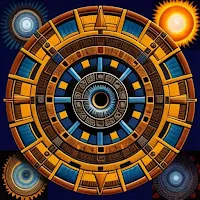Did the Aztec calendar predict solar eclipses?
Did the Aztec calendar predict solar eclipses?
The Aztec calendar, known as the Sun Stone or the Aztec Stone of the Sun, is a fascinating artifact that provides insight into the Aztec understanding of time and cosmology. While it does not explicitly predict solar eclipses in the way modern calendars do, it does reflect the Aztec's awareness of celestial events and their significance in their worldview.
1. Complex Timekeeping
The Aztec calendar system was highly complex and consisted of several interlocking cycles. The two main calendars were the xiuhpohualli, a 365-day agricultural calendar, and the tonalpohualli, a 260-day ritual calendar. These calendars operated simultaneously, with days being counted in cycles that repeated every 52 years.
2. Astronomical Awareness
The Aztecs were keen observers of the celestial bodies and incorporated their observations into their religious and cultural practices. They recognized the regular patterns of celestial events such as the movements of the sun, moon, and planets, and they associated these events with the actions of their deities.
3. Symbolism of Eclipses
Solar eclipses, in particular, held great significance for the Aztecs. They believed that during a solar eclipse, a cosmic battle took place between the forces of light and darkness. The temporary disappearance of the sun was seen as a sign of impending doom, and rituals were performed to ensure its return.
4. Artistic Depictions
The Sun Stone, also known as the Aztec Calendar Stone, contains intricate carvings that symbolize various aspects of Aztec cosmology, including the sun god Tonatiuh and other celestial bodies. While the stone itself does not directly predict eclipses, its intricate design reflects the Aztec's understanding of the cosmos and their reverence for celestial phenomena.
5. Cultural Interpretation
While the Aztecs did not possess the mathematical and astronomical knowledge to predict solar eclipses with precision, they certainly recognized their occurrence and imbued them with religious and cultural significance. Eclipses were seen as omens, often interpreted by priests and rulers to guide their actions and decisions.
In conclusion, while the Aztec calendar did not predict solar eclipses in the same way modern calendars do, it reflects the Aztec's deep understanding of celestial events and their significance in their religious and cultural worldview. Solar eclipses were viewed as cosmic battles between light and darkness, and their occurrence was interpreted as omens of great importance.
FAQ Facts:
1. Did the Aztecs have knowledge of solar eclipses?
Yes, the Aztecs were aware of solar eclipses and interpreted them within their religious and cultural beliefs.
2. Did the Aztec calendar include specific predictions for solar eclipses?
No, the Aztec calendar did not include specific predictions for solar eclipses as modern calendars do. However, they recognized their occurrence and attributed them with symbolic significance.
3. How did the Aztecs view solar eclipses?
Solar eclipses were seen as cosmic battles between light and darkness. They were interpreted as omens, often guiding the actions and decisions of priests and rulers.
4. Did the Aztec calendar Stone depict solar eclipses?
While the Aztec Calendar Stone did not specifically depict solar eclipses, its intricate carvings reflected the Aztec's understanding of celestial events and their reverence for cosmic phenomena.
5. How did the Aztecs react to solar eclipses?
During solar eclipses, the Aztecs performed rituals to ensure the return of the sun, as its temporary disappearance was perceived as a sign of impending doom.
